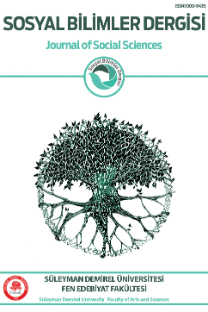A group of marble statuettes in the ödemiş museum
Ödemiş müzesinden bir grup mermer heykelcik
___
ALBAYRAK, Canan, Anadoluda Kybele - Attis Kültü 2007, 122 (unpublished master's thesis), Ankara, 2007.ALEXANDER, Christine, A Wooden Hekataion of the Hellenistic Period, The Metropolitan Museum of Art Bulletin, Vol. 34, No. 12, 272-274, 1939.
AYBEK, Serdar, Mehmet Tuna, Mahir Atıcı, İzmir Tarih ve Sanat Müzesi Heykel Kataloğu, fig. 37-38 Ankara 2009.
BARTMAN, Elizabeth, Ancient Sculptural Copies in Miniature, New York, 31-48, 1992.
BRAVI, Alessandra, Roman Sculpture in Asia Minor, Proceedings of the International Conference to celebrate the 50th anniversary of the Italian excavations at Hierapolis in Phrygia, held on May 24-26, 2007 in Cavallino(Lecce), Le immagini negli spazi pubblici di Perge in epoca adrianea,311, fig.20.7,JRA 80,2008.
BEAR, Drew Thomas, Afyon Müzesinde Bir Heykel Definesi, X. Araştırma Sonuçları Toplantısı, 147-152, Ankara,1992.
BIEBER, M., A Bronze Statuette in Cincinnati and Its Place in the History of the Asklepios Types, Proceedings of the American Philosophical Society, Vol. 101, No. 1 (Feb. 15, 1957), 70-92. 1957.
BØGH, Birgitte, Phrygian Background of Kybele Numen, Vol. 54, Fasc. 3, 316-317, 2007.
DAŞBACAK, Coşkun, Hecate Cults in Anatolia: Rituals and Dedications in Lagina, (Cult and Sanctuary Through the Ages From the Bronze Age to the Late Antiquity), 16-19 November, Slovakia, 143-148, 2007.
DANIEL, Robert W., Hekates Peplos Zeitschrift für Papyrologie und Epigraphik, Band. 72, 278, 1988.
GUALANDI, Giorgio, Artemis-Hekate Un Problema Di Tipologia Nella Scultura Ellenistica Revue Archéologique, Nouvelle Série, Fasc. 2, 1969, 233-272, 1969.
HANFMANN, George, M.A. Nancy H. Ramage, Sculpture from Sardis: The Finds Through 1975, Cambridge, 1978.
HAVELOCK, Christine Mitchell, Archaistic Reliefs of the Hellenistic Period, American Journal of Archaeology, Vol. 68, No. 1, 43-58, 1964.
HARCUM, G., Cornelia, A Statue of the Type Called the Venus Genetrix in the Royal Ontario Museum, American Journal of Archaeology, Vol. 31, No. 2, 141-152, 1927.
HUGHES, J. Donald, Artemis: Goddess of Conservation, Forest & Conservation History, Vol. 34, No. 4, 194, 1990.
HILL, Kent Dorothy, Venus in the Roman East, The Journal of the Walters Art Gallery, Vol. 31/32, 6,12, 1968/1969.
KOTSANAS, Kostas, The Musical Instruments Of The Ancient Greeks., 2012.
LANDWEHR, Christa, Die Römischen Skulpturen von Caesarea Mauretaniae, Ideal Plastik I, DAI Band 18, Berlin, 1993.
MÉTRAUX, Guy P. R., A New Head of Zeus from Sardis Author(s): American Journal of Archaeology Vol. 75, No. 2, 156. 1971.
MORSINK, Coreen Emmie Rose, The Composition of New MusicInspired by Music Philosophy and Musical Theoretical Writings from Ancient Greece, (unpublished doctoral thesis) London,15, 2013.
MITROPOULOU, Elpis, Triple Hekate Mainly on Votive Reliefs Coins Gems and Amulets, Athens, 67, fig.24bis, No. 5bis, 1978.
NAUMANN, Friederike, Die Ikonographie die Kybele in der phrygischen und der griechischen Kunst. Beiheft 28 der Istanbuler Mittelungen, Tübingen, 1983.
ÖZGAN, Ramazan, Die Skulpturen von Stratonikeia, Asia Minor Studien, Band 32, 48-49, 1999.
PENSABENE, Patrizio Roman Sculpture in Asia Minor, Proceedings of the International Conference to celebrate the 50th anniversary of the Italian excavations at Hierapolis in Phrygia, held on May 24-26, 2007 in Cavallino(Lecce), Su alcuni aspetti produttivi delle scuole di scultura di Docimio, Afrodisia e Nicomedia, 37-61, JRA 80, 2008.
PREISSHOFEN-Kabus, Renate, Die Hellenistische Plastik der Insel Kos, Mitteilungen des Deutschen Archaologischen Instituts, 14. Beiheft der Athenischen Abteilung, 57-63, 1989.
ROLLER, Lynn E., The Great Mother at Gordion: The Hellenization of an Anatolian Cult, The Journal of Hellenic Studies, Vol. 111, 128- 143,1991.
SCHLESINGER, Katherine. The Greek Aulos. London: Methuen & co., ltd.1939.
SMITH, RRR, Hellensitic Sculpture, London, Thames & Hudson, 2005.
STIRLING, M. Lea, Pagan Statuettes in Late Antique Corinth: Sculpture from the Panayia Domus, Hesperia: The Journal of the American School of Classical Studies at Athens, Vol. 77, No. 1,148,154, 2008.
SÖNMEZ, Devrim, Antik Dönemde Anadoluda Müzik ve Müzik Aletleri, (unpublished master's thesis), Konya, 2008.
ŞAHİN, N. Eda Akyürek, Anadoluda Hekate Korpusu ve Çeşitli Müzelerde Hekate Eserleri Üzerine Çalışmalar Bir Ön Rapor, Arkeoloji Sanat 121, 59-62, 2006.
ŞAHİN, N. Eda Akyürek, Antalya Müzesinden İki Hekateion, Adalya, XIV, 2011, 238-241, 2011.
ŞAHİN, Mustafa, Taşlıalan Mehmet, Smyrna Agorası Heykeltıraşlık Buluntuları, Olba XVIII, 205, Fig.41-42, 2010.
ŞİMŞEK, Celal, Roman Sculpture in Asia Minor, Proceedings of the International Conference to celebrate the 50th anniversary of the Italian excavations at Hierapolis in Phrygia, held on May 24-26, 2007 in Cavallino(Lecce), Sculpture from Laodikeia (Laodicea ad Lycum), 340, fig.22.9, JRA 80,2008.
IŞIK, Fahri, Doğa Ana Kubaba: Tanrıçaların Egede Buluşması, İstanbul 1999.
IŞIK, Fahri, Zur Entstehung Phrygischer Felsdenkmäler, Anatolian Studies, Vol. 37, 163-178, 1987.
İNAN, Jale, Roman Sculpture in Side, Ankara, 1975.
JANSON, Anthony F., History of Art. 5th edn. London: Thames & Hudson, 1995.
WEST, M. L., Ancient Greek Music, Oxford, 81, 1992.
WERTH, N., Hekate. Untersuchungen zur dreigestaltigen Göttin, Antiquitates 37, 2006.
- ISSN: 1300-9435
- Yayın Aralığı: 3
- Başlangıç: 1995
- Yayıncı: Süleyman Demirel Üniversitesi, Fen-Edebiyat Fakültesi
Gerçek hayattan esinlenen romanın ruhu ve hayatın simülasyonu üzerine bazı dikkatler
Denizli ve çevresinde avşar türkmenleri
Adnan Menderes KAYA, HAKAN KARAGÖZ
Belgrad kalesi'nde tamir ve imar faaliyetleri (1740-1743)
Çocuk gazetelerinin gözünden birinci dünya savaşı çocukları
Serbest Cumhuriyet fırkası'nın kurulması ve Cumhuriyet halk fırkası'nın gelişmelere bakışı
A group of marble statuettes in the ödemiş museum
